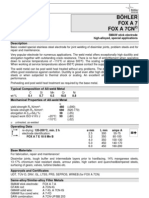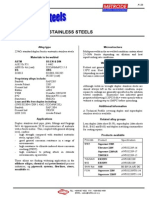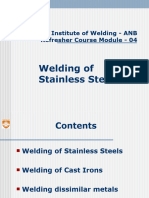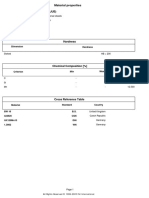Utp 63
Utp 63
Uploaded by
Eileen TylerCopyright:
Available Formats
Utp 63
Utp 63
Uploaded by
Eileen TylerOriginal Description:
Original Title
Copyright
Available Formats
Share this document
Did you find this document useful?
Is this content inappropriate?
Copyright:
Available Formats
Utp 63
Utp 63
Uploaded by
Eileen TylerCopyright:
Available Formats
Standards
AWS A5.4
DIN 8556
UTP 63
: E307-16
: E 18 8 Mn 6 R 26
Rutile electrode completely
austenitic based on CR Ni Mn Mo.
Universal usage.
Application Field
Completely austenitic electrode used to inter-connect and fill with carbon steel or bound or in junction welding
between this type of steel and Chromium-Nickel ones. It is equally indicated for junctions welding between steel
resistant to oxidation, subject to operational temperature up to 850C. Antimagnetic material and High Manganese
steel (Hadfield type) may be bound with each other with the use of this electrode. Used in coating parts subject to
solidification due to impact or wear caused by friction, such as: rail bending iron, trailing point, crusher tooth and
dredges, mortar milling beaters, etc. It forms an intermediate layer resistant to cracks over the normal hardness
materials or those with great hardness in hard coating, in addition to being perfectly suitable for root passes in
cladding plates.
Welding Characteristics
Good weldability in all positions, except descending vertical. Easy to remove the slag. The surface of the chords is
smooth. The antimagnetic deposit is highly resistant to cracks and it has great stretching capacity, balancing and
decreasing tensions. In case of mechanical requirements, the deposit tends to harden at cold temperatures. It resists
to oxidation up to 850C.
Mechanical Characteristics of the Deposited Metal
Flow limit
N/mm
>350
Resistance to traction
N/mm
>590
Stretching
%
>30
Charpy Essay
Impact V
60 J
Chemical Analysis of the Deposited Metal (in %)
C
0.08
Cr
19.0
Ni
10.0
Mn
4.0
Mo
0.70
Type of Current: CC (+) or CA
Machine Configuration
Electrode mm
Current A
2.5 x 300
50 - 70
3.25 x 350
70 - 100
4.0 x 350
100 - 130
5.0 x 450
130 - 160
Welding Instructions
Keep the electrode in vertical position; short or medium arch. Only use electrodes which are completely dry.
Thermal Treatment
Determine the preheating value as per the base material. Under no circumstances preheat the Hadfield Manganese
steel. Post thermal treatments in ferritic base materials in temperatures above 500C should be brief in order to avoid
Carbon heating in the line of fusion of the deposit for the transition zone.
WARNING:
The information presented herein should not be considered as a guarantee or certification for which we can be held
legally responsible. These are offered to the Clients for appreciation, investigation and verification. This
information may be altered without previous notice.
Oct/2005 Rev. 4
WELDING 0800-119002
You might also like
- Weld Like a Pro: Beginning to Advanced TechniquesFrom EverandWeld Like a Pro: Beginning to Advanced TechniquesRating: 4.5 out of 5 stars4.5/5 (6)
- UTP 655 32 SpecSheetDocument1 pageUTP 655 32 SpecSheetFadi HasnNo ratings yet
- Mild Steel Welding Electrodes: Salient FeaturesDocument16 pagesMild Steel Welding Electrodes: Salient FeaturesHandrea Hadi SaputraNo ratings yet
- GMAW Welding ParametersDocument32 pagesGMAW Welding Parametersnarutothunderjet216No ratings yet
- Railrod: Data SheetDocument1 pageRailrod: Data Sheetmohamed AdelNo ratings yet
- Böhler Foxa7 Fox A 7Cn: DescriptionDocument1 pageBöhler Foxa7 Fox A 7Cn: Description2003vinayNo ratings yet
- OK 48.20 ESAB 36 H (SPL) : A Basic Coated Low-Hydrogen Electrode For MMAW A Basic Coated Electrode For MMAWDocument1 pageOK 48.20 ESAB 36 H (SPL) : A Basic Coated Low-Hydrogen Electrode For MMAW A Basic Coated Electrode For MMAWGokul RajanNo ratings yet
- Utp 86 FNDocument1 pageUtp 86 FNc131508No ratings yet
- 570 950mpa High Tensile Strength SteelDocument32 pages570 950mpa High Tensile Strength SteelCarlos PadillaNo ratings yet
- A-80 RailrodDocument1 pageA-80 RailrodSyed AbudhakirNo ratings yet
- 1.smaw All PDFDocument76 pages1.smaw All PDFkaviatchennaiNo ratings yet
- Teromatec Eo 8355: Description Procedure of UseDocument1 pageTeromatec Eo 8355: Description Procedure of UseAravind rajNo ratings yet
- 78 PDFDocument1 page78 PDFGogo PNo ratings yet
- Metrode E2209 (B-60) ElectrodeDocument6 pagesMetrode E2209 (B-60) ElectrodeClaudia MmsNo ratings yet
- CERTILAS EN Edition2023 317Document1 pageCERTILAS EN Edition2023 317Alireza KhodabandehNo ratings yet
- Welding BasicsDocument37 pagesWelding BasicsSnehal DeshmukhNo ratings yet
- EutecTrode Manual Metal Arc Electrodes PDFDocument12 pagesEutecTrode Manual Metal Arc Electrodes PDFswapneel_kulkarniNo ratings yet
- CW CAT TABEL25!08!09 BewerkversieDocument46 pagesCW CAT TABEL25!08!09 BewerkversieAdeKusumahNo ratings yet
- 24UTP Railway GBDocument8 pages24UTP Railway GBwpsssamsungNo ratings yet
- L1 - 12937 - en - Thermanit 25 22 H - Marathon 104 - ENDocument1 pageL1 - 12937 - en - Thermanit 25 22 H - Marathon 104 - ENkamals55No ratings yet
- Recom. de Soldadura XARDocument4 pagesRecom. de Soldadura XARelias667No ratings yet
- 22%Cr Duplex Stainless Steels: Astm Bs en & Din BS UNS Proprietary Alloys IncludeDocument7 pages22%Cr Duplex Stainless Steels: Astm Bs en & Din BS UNS Proprietary Alloys IncludeNguyen Anh TuanNo ratings yet
- مكونات نقط اللحام شامل بنط اللحامDocument2 pagesمكونات نقط اللحام شامل بنط اللحامdaha333No ratings yet
- C101 Electrolytic Tough Pitch CopperDocument2 pagesC101 Electrolytic Tough Pitch CopperPradeep KumarNo ratings yet
- C101 Electrolytic Tough Pitch CopperDocument2 pagesC101 Electrolytic Tough Pitch CopperMADDI MADHAV.No ratings yet
- MIP - Bohler - Welding - Austria 316 PDFDocument1 pageMIP - Bohler - Welding - Austria 316 PDFbizo88No ratings yet
- Utp 84 FNDocument1 pageUtp 84 FNdurandm10No ratings yet
- Avesta 2205 AC DCDocument1 pageAvesta 2205 AC DCpipedown456No ratings yet
- Manganese 12 14%Document3 pagesManganese 12 14%Sreedhar Rakesh VellankiNo ratings yet
- WC 6000Document3 pagesWC 6000Sameer KhanNo ratings yet
- Welding of Copper and Its AlloysDocument30 pagesWelding of Copper and Its Alloysaj87_goswami100% (2)
- 2222XHDDocument1 page2222XHDmkpqNo ratings yet
- SS 1.4122Document2 pagesSS 1.4122Bipin Sadasivan100% (2)
- Arc Welding ElectrodesDocument6 pagesArc Welding ElectrodeswaleedyossefNo ratings yet
- Din 1.4003Document2 pagesDin 1.4003Dhaniel100% (1)
- D-Met 04 Welding of Stainless Steels, CI and Dissimilar WeldDocument42 pagesD-Met 04 Welding of Stainless Steels, CI and Dissimilar WeldTrepend Simplifying BusinessNo ratings yet
- Section 2 - Nikko Welding ConsumablesDocument9 pagesSection 2 - Nikko Welding Consumablesangga franugrahaNo ratings yet
- Bolted Aluminium Terminal Connectors For Substations: Material of CastingsDocument5 pagesBolted Aluminium Terminal Connectors For Substations: Material of CastingsTravis WoodNo ratings yet
- S S S S - 11018.M 11018.M 11018.M 11018.M: Hyundai Welding Co., LTDDocument6 pagesS S S S - 11018.M 11018.M 11018.M 11018.M: Hyundai Welding Co., LTDfaridshabaniNo ratings yet
- Weldability of Stainless SteelDocument29 pagesWeldability of Stainless SteelEr Mishal GandhiNo ratings yet
- Armox WeldingDocument2 pagesArmox WeldingsudhavelNo ratings yet
- Indian Institute of Welding - ANB Refresher Course - Module 07Document55 pagesIndian Institute of Welding - ANB Refresher Course - Module 07dayalram0% (1)
- B Bã-Hler Nibas 70 20-Fd Fcaw 02Document1 pageB Bã-Hler Nibas 70 20-Fd Fcaw 02kamals55No ratings yet
- Prima 18 8 MN 26Document1 pagePrima 18 8 MN 26varunkapoor varunelectrodes.comNo ratings yet
- Welding Austenitic Manganese Steel RailDocument6 pagesWelding Austenitic Manganese Steel RailaladinsaneNo ratings yet
- Steel Clasification and WeldabilityDocument32 pagesSteel Clasification and Weldabilitycentaury2013No ratings yet
- Cast Iron Welding AlloysDocument4 pagesCast Iron Welding AlloysKhin Aung ShweNo ratings yet
- Advanced Welding TechnologyDocument60 pagesAdvanced Welding TechnologySwati AgarwalNo ratings yet
- Welding WireDocument20 pagesWelding WirefoxmancementNo ratings yet
- Documents - Pub - Advanced Welding TechnologyDocument60 pagesDocuments - Pub - Advanced Welding TechnologybalamuruganNo ratings yet
- Esab DublexDocument8 pagesEsab DublexSuphi YükselNo ratings yet
- 1.4006 en PDFDocument2 pages1.4006 en PDFdiego.peinado8856No ratings yet
- Flux Cored Wires PDFDocument71 pagesFlux Cored Wires PDFCristian Camilo QuirogaNo ratings yet
- MIP Bohler Welding Austwqrwq2332e3eddwria 98Document1 pageMIP Bohler Welding Austwqrwq2332e3eddwria 98maxi27No ratings yet
- Welding, Brazing & Cutting - 11-21-2007Document7 pagesWelding, Brazing & Cutting - 11-21-2007Jimmy ClavelNo ratings yet
- Böhler CN 13/4-Mc Hi: Classifi CationsDocument1 pageBöhler CN 13/4-Mc Hi: Classifi CationsBranko FerenčakNo ratings yet
- .Au-Aluminium Alloy 3003Document5 pages.Au-Aluminium Alloy 3003ali alhamilNo ratings yet
- Oxy-Acetylene Welding and Cutting: Electric, Forge and Thermit Welding together with related methods and materials used in metal working and the oxygen process for removal of carbonFrom EverandOxy-Acetylene Welding and Cutting: Electric, Forge and Thermit Welding together with related methods and materials used in metal working and the oxygen process for removal of carbonNo ratings yet
- Nuu PDFDocument1 pageNuu PDFEileen TylerNo ratings yet
- Niu PDFDocument1 pageNiu PDFEileen TylerNo ratings yet
- C 4721Document2 pagesC 4721Eileen TylerNo ratings yet
- Untitled 63.4gpm N 237Document1 pageUntitled 63.4gpm N 237Eileen TylerNo ratings yet
- Niu PDFDocument1 pageNiu PDFEileen TylerNo ratings yet
- Untitled 100000Document1 pageUntitled 100000Eileen TylerNo ratings yet
- 1000 DDDDocument1 page1000 DDDEileen TylerNo ratings yet
- AsdfDocument1 pageAsdfEileen TylerNo ratings yet
- Balance ISO1940 G2.5Document1 pageBalance ISO1940 G2.5Eileen TylerNo ratings yet
- Untitled ErtqDocument1 pageUntitled ErtqEileen TylerNo ratings yet
- Zaq ZaqDocument1 pageZaq ZaqEileen TylerNo ratings yet
- Untitled DDDFRRRDocument1 pageUntitled DDDFRRREileen TylerNo ratings yet
- DasadDocument1 pageDasadEileen TylerNo ratings yet
- AsdewqDocument1 pageAsdewqEileen TylerNo ratings yet
- Concentric Pipe Presssure DropDocument1 pageConcentric Pipe Presssure DropEileen TylerNo ratings yet
- Concentric Pipe Presssure DropDocument1 pageConcentric Pipe Presssure DropEileen TylerNo ratings yet
- C 3160 (Yugoslavia / JUS) : Material PropertiesDocument1 pageC 3160 (Yugoslavia / JUS) : Material PropertiesEileen TylerNo ratings yet
- Untitled t65t65t65tDocument1 pageUntitled t65t65t65tEileen TylerNo ratings yet
- Untitled ErtDocument1 pageUntitled ErtEileen TylerNo ratings yet
- Untitled t65t65tDocument1 pageUntitled t65t65tEileen TylerNo ratings yet















































































